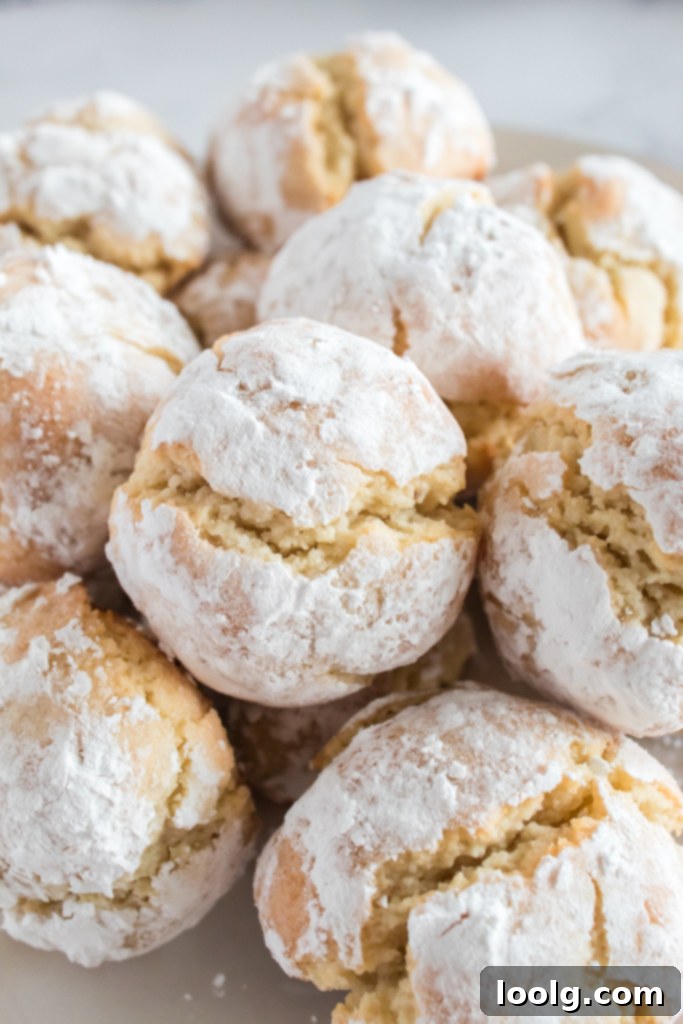Authentic Italian Almond Cookies (Ricciarelli): A Naturally Gluten-Free & Easy Recipe
Italian almond cookies, famously known as Ricciarelli, are a quintessential treat that beautifully marries simplicity with sophisticated flavor. Hailing from the historic city of Siena, Italy, these exquisite cookies have captivated palates for centuries. They are cherished for their delicate, crisp exterior that gives way to a wonderfully soft and delightfully chewy center. Crafted from a minimal selection of ingredients, Ricciarelli expertly showcase the rich, nuanced flavor of blanched almonds and the subtle, elegant sweetness of powdered sugar, creating an unforgettable culinary experience.
One of the most appealing aspects of these traditional Italian cookies is their remarkable ease of preparation. Unlike many intricate traditional baked goods that demand extensive time and specialized techniques, the dough for Ricciarelli is incredibly straightforward to make, requiring minimal effort and surprisingly little time from start to finish. This makes them an ideal choice for both seasoned bakers and novices alike, promising a delightful reward with relatively simple steps.
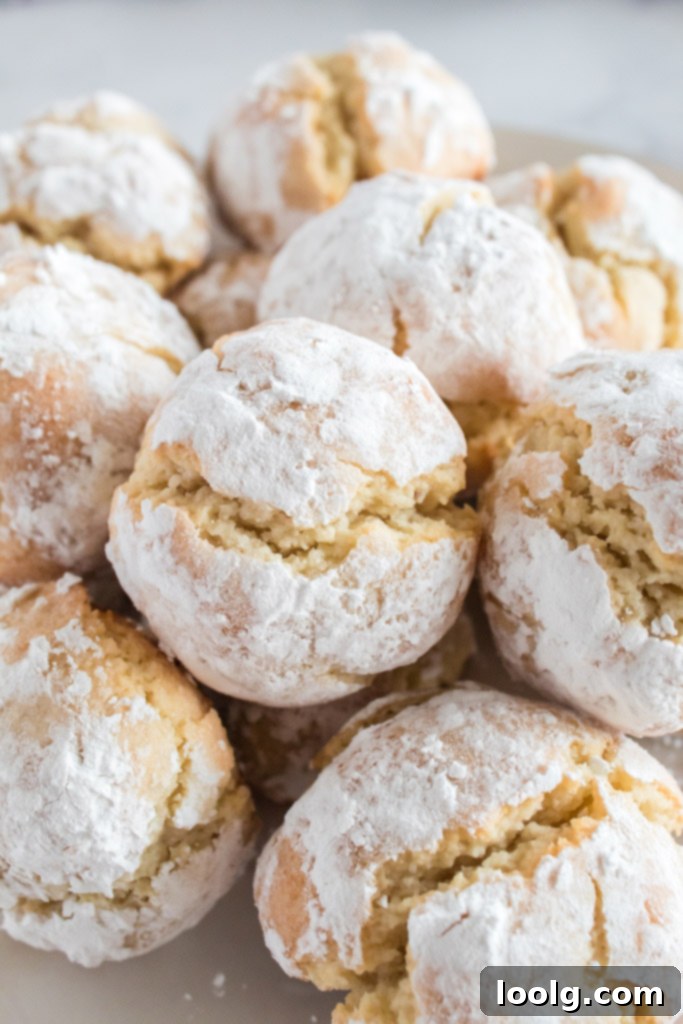
The magic of these cookies begins with a simple yet powerful combination of fine almond flour, fresh egg whites, and sugar. This humble dough transforms in the warmth of the oven, where it develops its characteristic crackled surface, a hallmark of true Ricciarelli, and bakes to a beautiful golden-edged perfection. The carefully balanced ingredients ensure that each bite delivers that signature melt-in-your-mouth texture that has made these cookies a beloved Italian classic.
Beyond their irresistible taste and texture, Ricciarelli are naturally gluten-free. This inherent quality makes them a superb choice for individuals with celiac disease or gluten sensitivities, allowing everyone to indulge in a delicious, authentic Italian dessert without compromising on flavor or the luxurious texture. Their inclusion-friendly nature further solidifies their status as a versatile and universally loved sweet treat.
While Ricciarelli are deeply rooted in Italian Christmas traditions, symbolizing holiday cheer and festive gatherings, my personal preference extends their enjoyment to other celebrations, particularly Easter. Their elegant appearance and rich flavor make them equally suitable for spring festivities. This enduring appeal across different seasons is precisely why I’m excited to re-share this recipe today, five years after its initial publication, enriched with even more comprehensive information and invaluable tips to ensure your baking success.
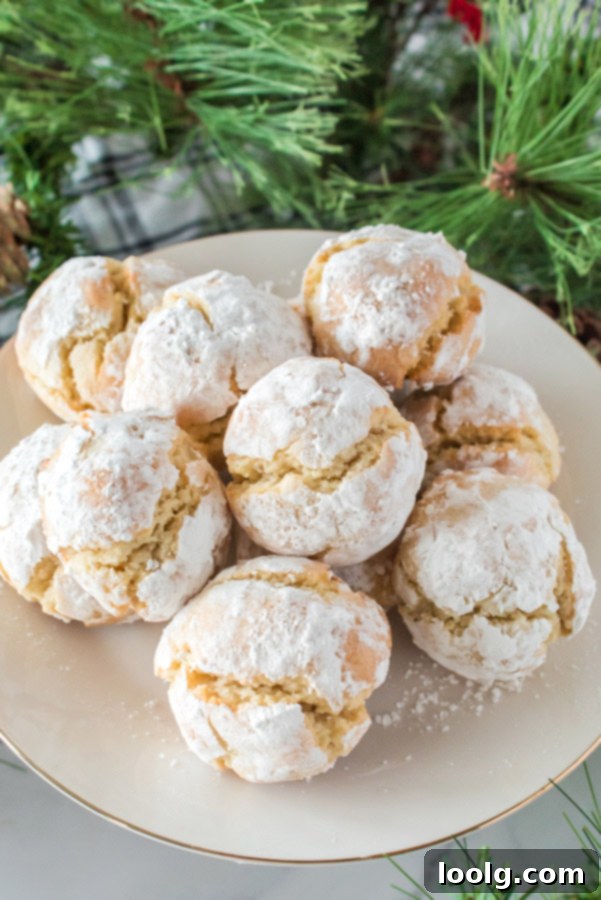
What Are Ricciarelli? A Journey into Sienese Pastry
Ricciarelli are much more than just cookies; they are a historical delicacy, traditional almond-based confections originating from the heart of Siena, Italy. Tracing their lineage back to the 14th century, these unique cookies are instantly recognizable by their distinctively cracked, snowy surface, generously dusted with powdered sugar. Every bite reveals a delicately crisp exterior that yields to a remarkably dense, moist, and chewy interior, a texture profile unlike any other almond cookie.
A common misconception is to compare Ricciarelli to biscotti, another famous Italian biscuit. However, their textures are fundamentally different. While biscotti are known for their firm, crunchy consistency, Ricciarelli are celebrated for their ethereal quality, literally melting in your mouth. This luxurious texture is primarily attributed to their base of finely ground almond flour, coupled with the binding and leavening properties of whipped egg whites. The high almond content not only provides a rich flavor but also contributes to their tender crumb.
Deeply woven into the fabric of Italian culture, particularly during festive periods, Ricciarelli are a staple on holiday tables, bringing a touch of traditional elegance. However, their delightful taste makes them a treat to be savored year-round, perfect with a cup of coffee or as a light dessert. Their intense almond flavor is a huge hit among enthusiasts of marzipan and other nut-based sweets, offering a refined taste experience. If you appreciate such delights, you might also enjoy these German Almond Paste Cookies!
While the beauty of Ricciarelli lies in their traditional simplicity, with just a few core ingredients, modern variations have emerged to offer diverse flavor profiles. Incorporating bright citrus zest, such as lemon or orange, or a hint of aromatic vanilla extract, can add a refreshing or warmly comforting twist to this timeless treat. These subtle additions enhance the cookie without overshadowing its inherent almond essence, providing a personalized touch to a beloved classic.
Why You’ll Fall in Love with These Italian Almond Cookies
- These authentic Italian almond cookies are crafted with just five simple ingredients, yet they deliver an unbelievably rich and complex flavor that belies their minimal composition. The focus on quality ingredients truly shines through.
- They are naturally gluten-free, grain-free, and dairy-free, making them an excellent and inclusive option for nearly all dietary needs and preferences. You won’t have to sacrifice taste or texture for health considerations.
- Ricciarelli are surprisingly quick and easy to make, requiring minimal hands-on effort and no specialized baking techniques. This recipe is designed for accessibility, ensuring a delightful baking experience for everyone.
- Perfect for the festive season, these cookies look absolutely stunning on any Christmas cookie platter, adding an elegant touch to your holiday spread. Their robust nature also makes them ideal for packaging up and giving as thoughtful, homemade gifts to friends and family. They’re a truly versatile holiday treat, much like these delightful Chocolate Covered Dates.
Essential Ingredients for Perfect Ricciarelli
The magic of Ricciarelli truly lies in the quality and careful selection of its core ingredients. This recipe prides itself on its simplicity, featuring just five fundamental components that come together to create a harmonious and unforgettable flavor:
- Almond flour – The cornerstone of these cookies, almond flour is not a one-size-fits-all ingredient. For the signature texture of Ricciarelli, it is absolutely crucial to use *finely ground blanched almond flour*. Coarser almond meal, which includes the skin, will absorb liquids differently and can cause your cookies to spread excessively and become overly moist or flat. If you find your initial test batch spreads more than desired, you can easily adjust the dough consistency by adding an additional 1/3 cup (approximately 33 grams) of almond flour. This small adjustment can significantly impact the final texture, ensuring your Ricciarelli hold their perfect shape and chewiness.
- Granulated sugar – While traditional Ricciarelli recipes predominantly use granulated sugar for its clean sweetness and structural contribution, you might consider coconut sugar as an alternative. However, be mindful that coconut sugar possesses a darker, more caramel-like flavor and color, which will subtly alter both the taste and the classic pale appearance of your cookies. It’s a worthy experiment for a different flavor profile, but for authentic Ricciarelli, granulated sugar is key.
- Egg whites – Essential for both binding the dough and creating the characteristic light, chewy interior, egg whites are indispensable in this recipe. Their ability to whip up into soft peaks adds crucial aeration. Unfortunately, egg substitutes like flax eggs or chia eggs will not provide the necessary structure and aeration required for these cookies to achieve their unique texture, so fresh egg whites are a must.
- Almond extract – While purists might argue for a strictly traditional approach, adding a small amount of almond extract is a secret weapon to intensify and deepen the overall almond essence of the cookies. This enhancement is particularly appreciated by those who adore the rich, concentrated flavor found in marzipan and other almond-based confections. Although not strictly “authentic” in some historical recipes, my taste testers consistently preferred the version with a touch of almond extract for its heightened flavor. For a delightful twist, if you prefer a bright lemon version of these cookies, simply swap the almond extract for lemon extract and incorporate 2 tablespoons of finely grated lemon zest. For more zingy lemon cookie fun, you might also want to try these Lemon Sugar Cookies with Olive Oil!
- Powdered sugar – This ingredient serves a dual purpose: it’s used generously for rolling the cookie dough balls, which is absolutely vital for developing their iconic crackled surface during baking, and it also adds an extra layer of delicate sweetness and an elegant finish. Do not skip this step!
Step-by-Step: How to Make These Exquisite Italian Almond Cookies
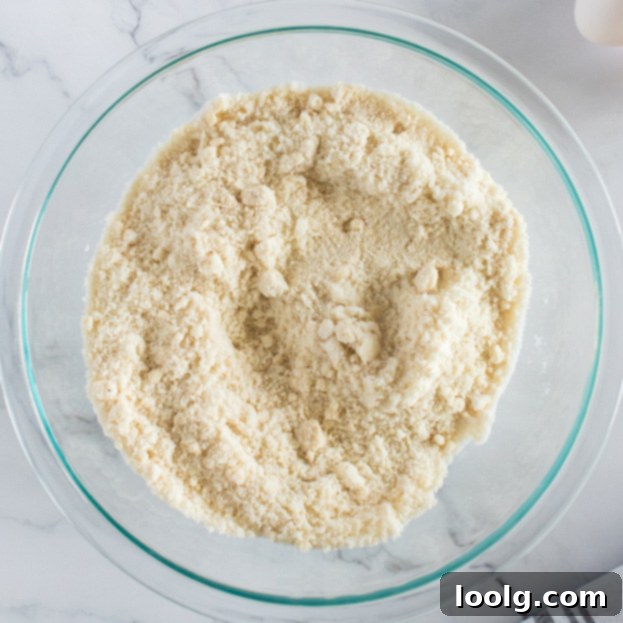
Step 1: Combine Dry Ingredients. In a medium-sized bowl, thoroughly mix together the finely ground almond flour, granulated sugar, and a pinch of salt. Ensure these ingredients are well combined and uniform before proceeding. This initial step helps to evenly distribute the flavors and create a consistent base for your dough.
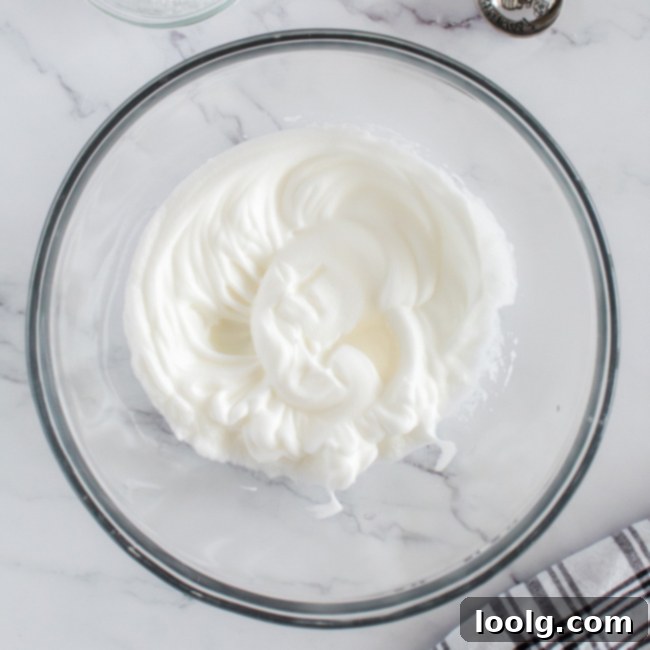
Step 2: Whip Egg Whites. In a separate, large mixing bowl, using an electric hand mixer or a stand mixer, beat the room temperature egg whites until they form soft, airy peaks. Once soft peaks are achieved, gently fold in the almond extract. The aeration from the whipped egg whites is critical for the cookies’ light and chewy texture.
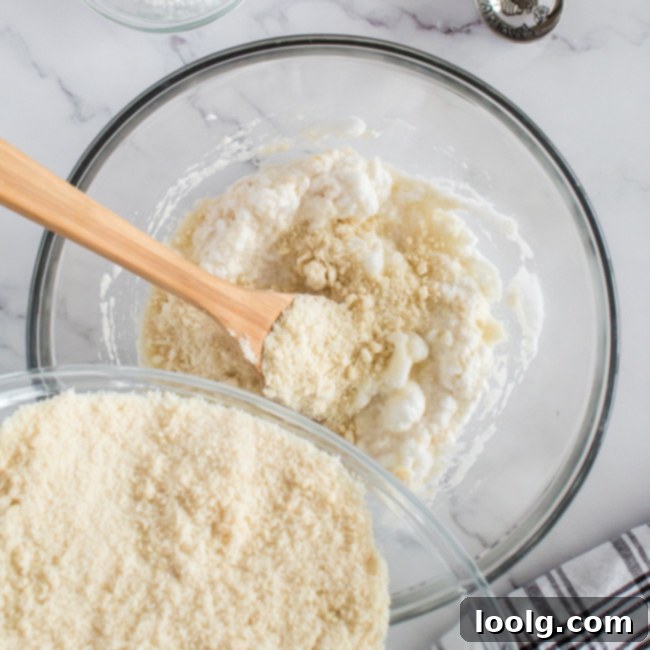
Step 3: Combine Wet and Dry. Carefully pour the prepared dry ingredient mixture into the bowl containing the whipped egg whites. At this stage, the mixture might appear somewhat unusual or clumpy, resembling a thick paste rather than a smooth dough. This is completely normal and part of the process for achieving the unique Ricciarelli texture.
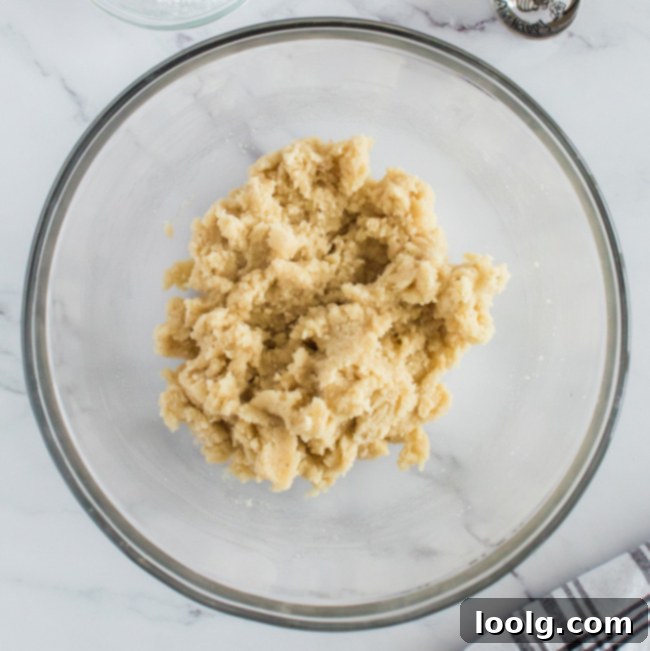
Step 4: Form the Dough. Continue mixing the ingredients, either by hand with a sturdy spatula or on low speed with your mixer, until they are fully incorporated and you have a uniform, thick, and slightly sticky dough. Ensure there are no pockets of dry flour and that the mixture is consistently smooth. This step ensures the dough has the right consistency for shaping.
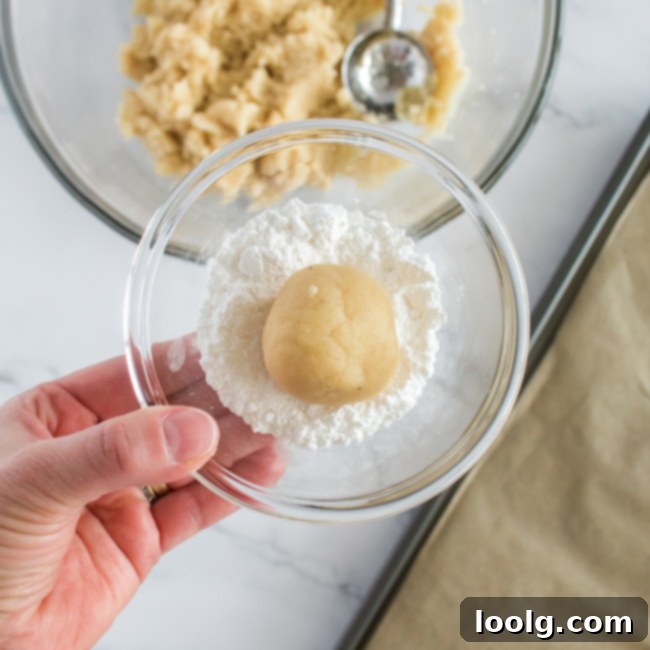
Step 5: Shape and Coat. Using about 1 1/2 tablespoons of dough per cookie, roll the dough into uniform balls. Then, generously coat each ball in powdered sugar. This heavy coating of powdered sugar is not merely for aesthetics; it’s essential for creating the signature crackled surface of Ricciarelli during baking. Ensure a thick and even layer for the best results.
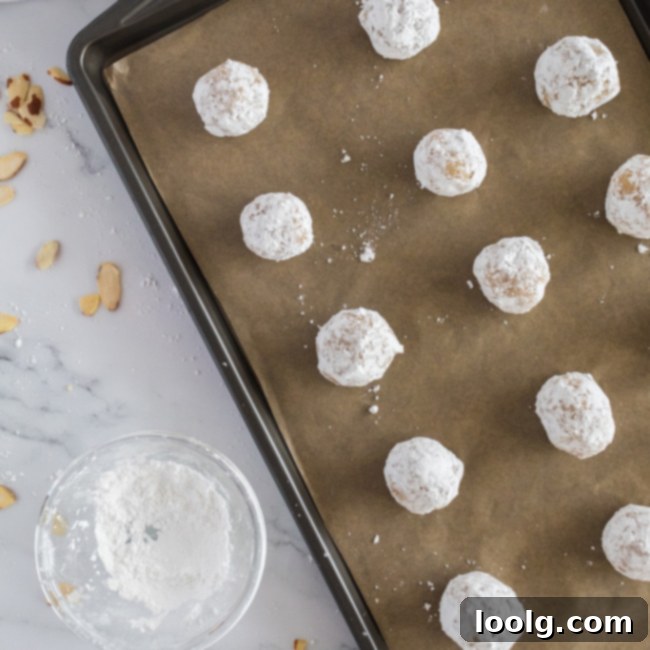
Step 6: Bake to Perfection. Place the coated cookie dough balls onto your prepared baking sheet, ensuring they are spaced about 2 inches apart to allow for slight spreading. Bake for approximately 15-17 minutes in a preheated oven, or until the tops have developed their beautiful, characteristic crackles and the bottoms are lightly golden brown. Be careful not to overbake, as these cookies are meant to retain a soft, chewy interior.
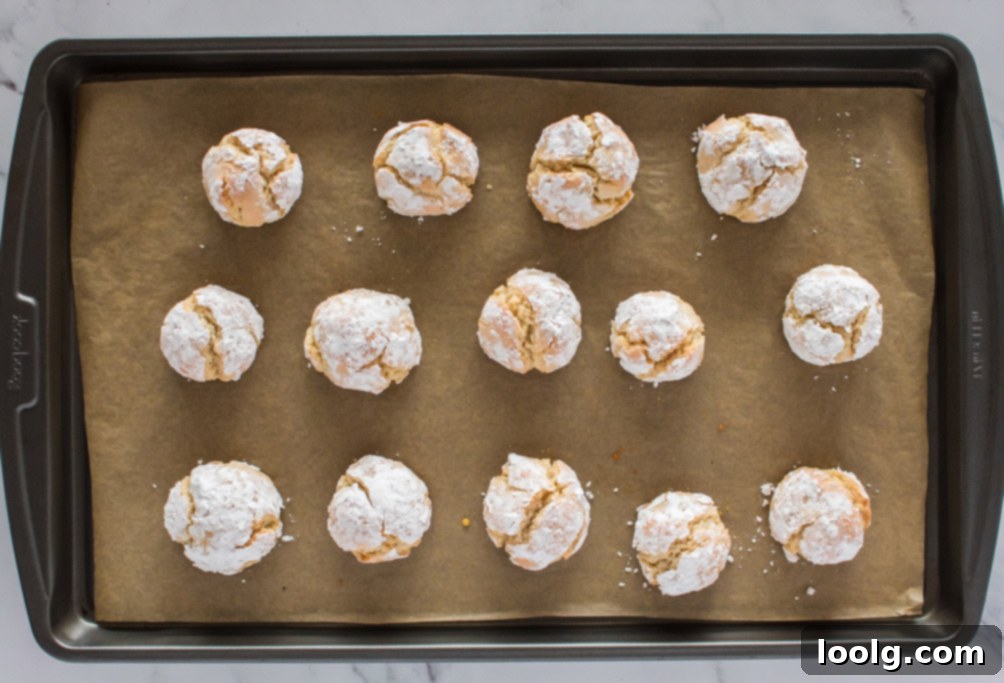
Expert Baking Tips for Flawless Ricciarelli
Achieving the perfect Ricciarelli with their ideal crisp-chewy texture and distinctive crackled tops is simple when you keep these expert tips in mind:
- Always use room temperature egg whites. They whip up much faster and achieve greater volume than cold egg whites, which is essential for the delicate structure of these cookies.
- Before baking your entire batch, consider making a single test cookie. This allows you to check for proper spreading and adjust the dough (e.g., adding a little more almond flour if it spreads too much) before committing to the whole tray. It’s a quick way to guarantee consistent results.
- If your dough feels excessively sticky and challenging to roll, don’t hesitate to refrigerate it for about 30 minutes. Chilling the dough will firm it up, making it significantly easier to handle and shape into perfect balls.
- The most crucial advice: do not overbake! Ricciarelli are meant to be soft and wonderfully chewy on the inside. Overbaking will dry them out, making them hard and crumbly, and you’ll lose that signature melt-in-your-mouth quality. Watch for the crackled tops and lightly browned bottoms, then remove them promptly.
The following tips are particularly important for achieving that beautiful, iconic crackled surface:
- Roll the dough balls generously in powdered sugar before baking – not after. A thick, even coating of powdered sugar is what creates the unique crackle effect as the cookie bakes and expands. The sugar dries out and fractures, forming the beautiful signature pattern.
- Bake at the right temperature. An oven that is too hot can cause the cookies to spread out too much and flatten excessively, preventing the proper development of the crackled top. Conversely, a temperature that is too low may hinder the cracking process altogether. Follow the recommended oven temperature precisely.
- Avoid overmixing the dough. Once the wet and dry ingredients are just combined and uniform, stop mixing. Overmixing can develop the proteins in the egg whites more than desired, leading to a denser, tougher cookie rather than the light and chewy texture you’re aiming for.
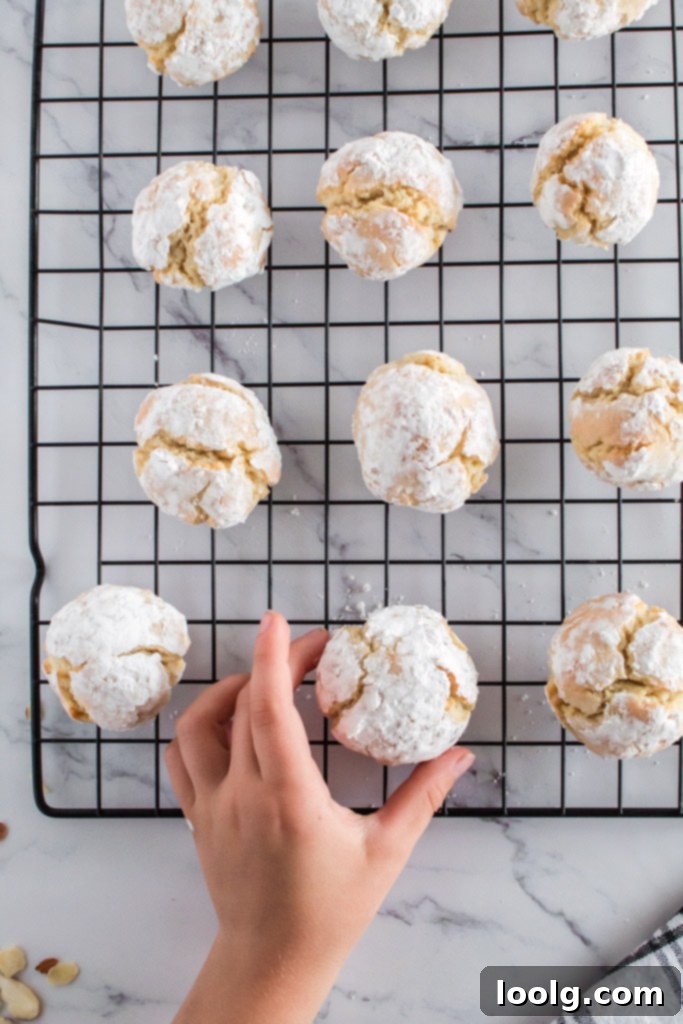
Storage and Freezing Tips for Long-Lasting Freshness
Ensuring your homemade Ricciarelli stay as fresh and delicious as the day they were baked is simple with proper storage techniques. These delightful Italian almond cookies will remain fresh and retain their optimal texture for up to a full week when stored correctly. Place them in an airtight container at room temperature, ideally in a cool, dry place away from direct sunlight or excessive humidity. This environment helps to preserve their distinct crisp exterior and that wonderfully soft, chewy center that makes them so irresistible.
For those looking to prepare a batch ahead of time or simply extend their enjoyment, Ricciarelli freeze exceptionally well. To freeze them, first arrange the baked and cooled cookies in a single layer on a baking sheet. Place the baking sheet in the freezer until the cookies are firm, typically for about 1-2 hours. This initial flash-freezing step prevents the cookies from sticking together. Once firm, transfer the frozen cookies to an airtight freezer-safe container or a heavy-duty freezer bag. They can be stored in the freezer for up to 3 months without any significant loss of quality. When you’re ready to enjoy them, simply thaw the cookies at room temperature for an hour or two before serving. They will taste as if they were freshly baked!
Naturally Gluten-Free Christmas Cookies for Everyone
Ricciarelli truly stand out as a fantastic and thoughtful gluten-free option for your Christmas cookie repertoire. Their composition naturally excludes wheat and dairy, and there’s no need for any specialty gluten-free flour blends, which often involve a mix of various starches and gums. This makes them an inherently pure and uncomplicated choice for those navigating dietary restrictions. The simple, wholesome ingredients ensure that these cookies are not just gluten-free, but also a truly delightful and authentic experience for everyone.
I’ve personally been baking these incredible cookies for over two decades, and in all that time, I’ve consistently observed their universal appeal. Even individuals who don’t follow a gluten-free diet absolutely adore them and frequently ask for the recipe. Their rich almond flavor and unique texture transcend dietary preferences, making them a festive favorite for all. They prove that gluten-free baking can be just as, if not more, delicious and satisfying than traditional methods, bringing joy to every palate during the holidays.
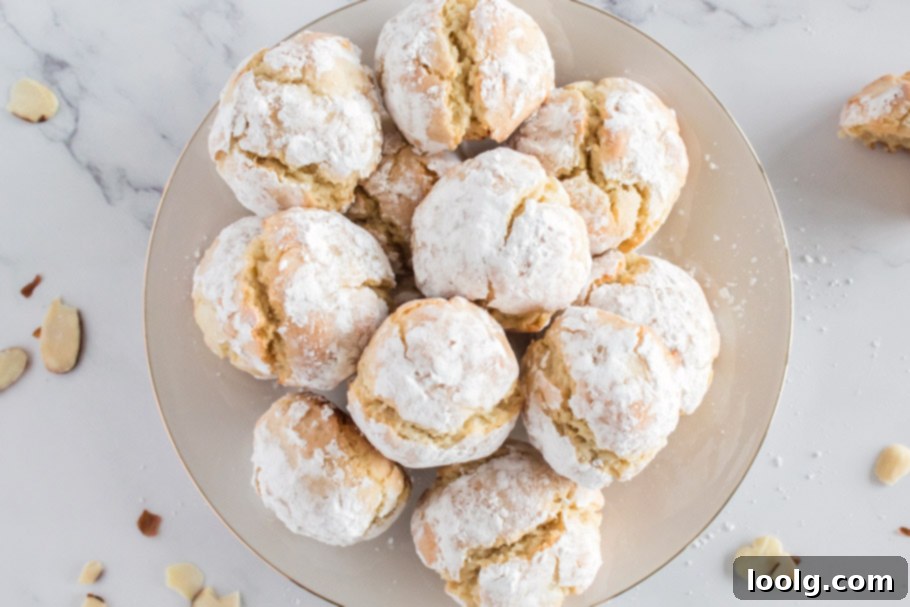
The widespread appreciation for these Ricciarelli extends to many of my other almond flour-based recipes, which also receive rave reviews from both gluten-free and gluten-loving individuals. Explore more almond flour delights with these fan-favorite recipes: Almond Flour Sugar Cookies, decadent Almond Flour Brownies, and wholesome Almond Flour Oatmeal Cookies.
Frequently Asked Questions About Italian Almond Cookies (Ricciarelli)
While we’ve covered some key points regarding ingredients in the section above, here are some more detailed answers to common questions about making these exquisite cookies, ensuring your baking experience is as smooth as possible.
Can I use regular flour (all-purpose, cake, etc.) instead of almond flour?
No, absolutely not. For this specific recipe, you *must* use finely blanched almond flour. Regular flours like all-purpose, cake flour, or bread flour have vastly different protein and starch compositions compared to almond flour. They absorb liquids differently and possess gluten, which almond flour lacks. Substituting regular flour will drastically alter the texture, taste, and structure, resulting in cookies that will not resemble authentic Ricciarelli at all.
Can I grind whole almonds into flour for this recipe?
While you can grind whole almonds into a form of almond meal using a food processor, it’s highly unlikely you will achieve the ultra-fine consistency of commercially produced, store-bought blanched almond flour. The texture will be significantly coarser, and processing whole almonds often releases more oils, which can make your dough overly moist. This will almost certainly result in your cookies spreading much flatter during baking and having a greasy, rather than chewy, interior. For the best and most authentic Ricciarelli texture, using finely ground, store-bought blanched almond flour is strongly recommended.
Can I use a different sweetener other than granulated sugar?
As mentioned in the ingredients section, coconut sugar *can* work as an alternative, but it will undeniably impart a darker color and a distinct caramel-like flavor, altering the traditional taste and appearance of Ricciarelli. However, liquid sweeteners such as honey, maple syrup, or agave nectar are generally not suitable for this recipe. They would add too much excess liquid to the dough, significantly disrupting its delicate balance and consistency, leading to a dough that is impossible to shape and cookies that will not set properly.
Can I make these cookies vegan?
Due to the critical role of whipped egg whites in providing structure and aeration to these cookies, directly substituting with common egg alternatives like chia or flax eggs will unfortunately not work. These substitutes cannot replicate the foaming and binding properties of egg whites. For a successful vegan version of Ricciarelli, I highly recommend seeking out a recipe specifically designed for it, often featuring aquafaba (the liquid from canned chickpeas) as an excellent substitute for whipped egg whites. For example, a recipe similar to this Vegan Ricciarelli using aquafaba would be your best bet.
Can I add chocolate to these Italian almond cookies?
Yes, absolutely! While not traditionally part of the classic Ricciarelli, adding chocolate can be a delightful modern twist. You can either dip the cooled cookies in melted semi-sweet or dark chocolate for an elegant finish, or gently fold in some mini semi-sweet chocolate chips into the dough before shaping for a more integrated chocolate flavor. It’s a non-traditional but undeniably delicious variation that many enjoy!
Looking for more festive baking inspiration beyond these Italian delights? You might enjoy creating these Allergy-friendly Roll-out Sugar Cookies for another versatile treat. For an equally impressive and traditional Italian cookie, these Pizzelle Cookies look absolutely amazing and offer a different texture profile. And if you find yourself without almond flour on hand and prefer not to purchase it, these simple yet elegant Russian Tea Cakes offer another easy and satisfying Christmas cookie recipe option.
✨🍪Did you try these incredible Italian almond cookies? 🍪✨
Your feedback is invaluable! Please take a moment to share your experience by leaving a ✍️review and 🌟 rating – it helps me and fellow bakers in our community! I so appreciate it. 💖
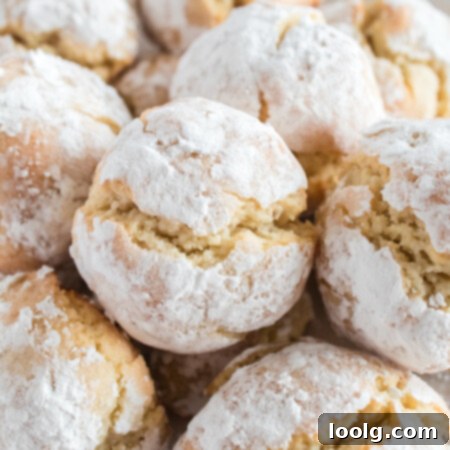
Italian Almond Cookies
Ingredients
- 2 cups (200 grams) finely blanched almond flour
- 1 cup (200 grams) granulated sugar
- 1/8 teaspoon salt
- 2 large egg whites room temperature
- 1 teaspoon almond extract
- 1/4 cup (29 grams) powdered sugar, for rolling
Instructions
-
Preheat your oven to 350 °F (175 °C). Line a large baking sheet with a piece of parchment paper to prevent sticking and ensure easy cleanup.
-
In a medium mixing bowl, combine the almond flour, granulated sugar, and salt. Stir these dry ingredients together thoroughly with a whisk or spoon until they are well combined and uniform. Set this bowl aside for a moment.
-
In a separate, large mixing bowl, using an electric hand mixer or a stand mixer fitted with the whisk attachment, beat the egg whites at medium speed until soft peaks begin to form. Once the egg whites are light and fluffy with soft peaks, gently stir in the almond extract. Then, gradually add the reserved almond flour mixture into the whipped egg whites. It will start to form a very thick, almost paste-like dough at this stage.
-
The consistency of your almond flour can affect how much your cookies spread. Finely blanched almond flour typically results in less spreading. I strongly recommend baking a single “test cookie” before baking the entire batch. If this test cookie bakes up nicely and holds its shape with a good crackle, proceed with the rest of the dough. If it spreads too flat for your liking, you may need to add up to about 1/3 cup (33 grams) more almond flour to the remaining dough to achieve a firmer consistency. In my experience, even with this adjustment, the cookies remain perfectly sweet and retain their delicious texture.
-
Once the dough is ready, scoop out portions of about 1 1/2 tablespoons each. Roll these portions into neat balls, then generously roll each ball in powdered sugar until it is thoroughly coated. A thick coating is key for the beautiful crackled effect. Place the sugar-coated cookie balls onto your prepared baking sheet, ensuring they are spaced approximately 2 inches apart to allow for proper airflow and slight expansion during baking.
-
Bake the cookies for 15-17 minutes. You’ll know they’re ready when their tops have developed their signature crackled appearance and the bottoms are lightly golden brown. Remember not to overbake; these cookies are meant to have a soft and chewy interior. Once baked, remove the sheet from the oven and allow the cookies to cool completely on the baking sheet. This allows them to firm up without becoming brittle. Store the cooled cookies in an airtight container at room temperature for up to a week for optimal freshness.
Notes
Nutrition
